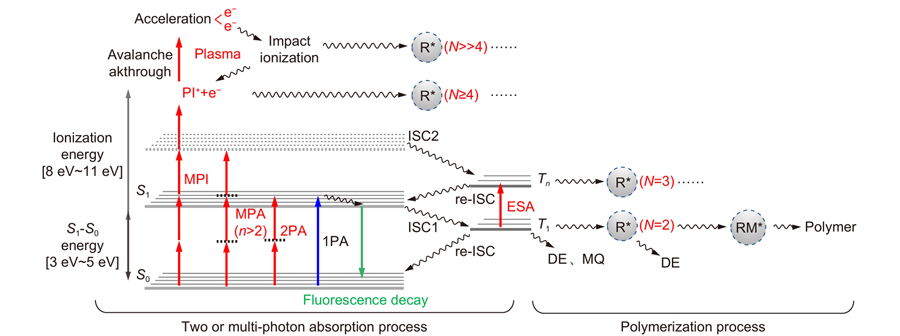
1 暨南大学 光子技术研究院 广东省光纤传感与通信技术重点实验室,广东 广州 511443
2 中国科学院理化技术研究所 仿生智能界面科学中心 有机纳米光子学实验室,北京 100190
Overview: Femtosecond laser two-photon polymerization (TPP) micro-nanofabrication technology is a new type of three-dimensional lithography technology that integrates nonlinear optics, ultra-fast pulsed laser, microscopic imaging, ultra-high-precision positioning, three-dimensional (3D) graphics CAD modeling, and photochemical materials. It has the characteristics of simplicity, low cost, high resolution, true 3D, and so on. Different from the technical route of shortening the wavelength of the traditional lithography, this TPP technology breaks through the optical diffraction limit using the ultrafast laser in the near-infrared and the nonlinear optical effect of the interaction between the laser and the material. TPP can achieve true 3D fabrication of complex 3D structures. After the femtosecond pulse laser is tightly focused in space, photopolymerization is initiated by the two-photon absorption(TPA), which can limit the fabrication area in the center of the focus. The interaction time of the ultrashort pulse with the material is much lower than the thermal relaxation of the material, avoiding the photothermal effect. The lateral linewidth can be reduced to about 100 nm due to the strong threshold characteristics of the two-photon absorption process. Thus, TPP is an ideal fabrication method in the field of 3D micro-nanostructure. Since 2001, Kawata’s team has used a near-infrared femtosecond laser with a wavelength of 780 nm to fabricate a "nanobull" with the size of red blood cells. It fully demonstrated the advantages of TPP in the preparation of three-dimensional micro-nano structures. At the same time, a polymer nanodot with a size of 120 nm was fabricated, which was only 1/7 of the laser wavelength, breaking the optical diffraction limit in this study. Since then, scientists from various countries have improved the line width, resolution, and other parameters of 3D structure by continuously improving the materials, structure, processing technology and light field control, and other aspects. At the same time, with the continuous development and improvement of the 3D nanostructure fabrication technology, the advantages of TPP technology are also reflected in some application fields, such as micro-optical devices, integrated optical devices, micro-electromechanical systems, and biomedical devices. This paper will systematically introduce the femtosecond laser TPP micro-nanofabrication technology, including the fabricating principle, the development of fabricating methods, and its research overview in many application fields. Finally, its existing problems and future development and application prospects are discussed.
飞秒激光 双光子聚合 光学衍射极限 加工分辨力 加工效率 femtosecond laser two-photon polymerization optical diffraction limit resolution efficiency 




